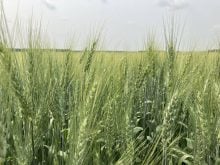DENVER, Colo. – The latest technology confirms that water is the most significant yield limiting factor in southern Alberta.
That isn’t much of a surprise, but the research has also found that wide swings in nutrients in the soil create economic opportunities to manage inputs once the potential for yield is established.
“Farmers have hoped there is a magic bullet, one right combination of nutrients, one best practice,” said Alex Melnitchouck, a research agronomist with Dynagra in Beiseker, Alta.
“But it is more about getting it all right, keeping costs low and then getting enough moisture.”
Read Also

Why feds imposed EV tariffs
Moe and Kinew have a fight on their hands when it comes to eliminating the EV tariff. Canada has to worry about pissing off the U.S. and Mexico and hundreds of thousands of auto workers.
Melnitchouck told agrologists and researchers attending the recent annual International Conference of Precision Agriculture in Denver that his research into the role of nutrition and water in determining yields includes satellite imaging, soil sampling and other precision agriculture techniques.
“NDVI (normalized difference vegetation index maps) have a high correlation with yield maps so (satellite) maps can be used to calculate yield,” he said of the yardstick that was used to measure a 221 acre field near Calgary.
Soil samples were taken in a grid at two depths and tested for 20 factors, including organic matter, pH, cation exchange capacity and content levels of macro and micronutrients.
The field’s topography was examined using high-resolution elevation data.
Melnitchouck said producers often think soil salinity, compaction and nutrient shortages are the major yield obstacles in their fields.
“When they apply nutrients, they generally use a single fertilizer prescription for the whole field, aiming for an average yield.… This results in over applying in the areas where it is not likely to do any good and under applying where there is highest potential.”
This often results in the accumulation of nutrients in areas where the plants are not making use of them, such as hills and saline areas, or where organic matter is low.
“Soil types tended to follow topography, but nitrogen and phosphorus were distributed very differently,” he said.
NDVI mapping of the crop at its vegetative peak showed the yield was highest where the organic matter was heaviest. This was also where the moisture tended to accumulate, in the lower areas of the field.
“In Alberta soil, organic matter and moisture go together and this has a strong correlation with the contours of a field’s surface,” he said. “Moisture tends to be the limiting factor.”
Research shows that NDVI and topographical maps can reliably predict yield trends when making maps and planning for field nutrient prescriptions.
The soil sampling on the 221 acre field also found a strong relationship between potassium deficiency and the NDVI map.
“Farmers on the Prairies don’t usually consider applying potassium to their fields.”
Melnitchouck said this might be worth looking at in some cases.
“We were surprised to find there was no linear relationship between yield and nitrogen and cation exchange capacity,” he said.
“This told the researchers that the ability of the soil to hold cation nutrients was less important than was the ability to hold moisture. Phosphorus levels throughout the field were not associated with green biomass production.”
Electrical conductivity of the soil and salt concentrations were other factors in the study that weren’t associated with yield.
“In the end, it’s water that matters most. The most important nutrient is nitrogen, and to take advantage of it, the crop needs water.”
Many factors come into play when producers create management zones in their fields. However, he said it appears from this study that NDVI and topography are the most important factors when predicting yields.














